- Home
- Project Portfolio
- Project Selection
Project Selection
Published: 2009-07-06
Last updated: 2022-03-20
Project selection is the first important part of project portfolio management.
Who is responsible for the selection and review of projects?
The responsibility is with the leadership team of the organization. Typically, they establish a steering committee that overlooks the process of selecting projects, including project monitoring, and directly reporting to the CEO – if the CEO is not a member of that steering committee already.
The leading question is:
"How can we make sure that we are doing the right projects?"
We assume that the organization has a strategy in place that covers the next three to ten years, depending on the type of business the organization is in. This strategy identifies areas where the organization
- Needs to improve or change in terms of organizational structure, research and development capacity, development of products, office space, manufacturing capacity, etc.
- Wants to serve customers in order to earn money.
Then, our leading question for the selection of projects turns into:
"How can we make sure that we are doing only projects that support
our strategy in these two areas?"
Answering this question for the first area leads to investment projects; for the second area it leads to customer projects.
All these projects need resources partially or fully provided by the organization itself. Since these resources are limited not all of the projects we would like to pursue can be staffed or funded adequately.
So, projects in different areas will compete with each other in order to get support of the organization in terms of staffing and funding.
The generic process of project selection looks as follows.
(1) Identification of Projects
The first step of this process, identification, requires a clearly defined and communicated strategy. The best option would be to set up a strategy development process that contains project identification and project selection as an integral part (cf. "How to Find the Right Projects" in sub-section White Papers). In fact, we observe that most organizations identify investment projects within their strategy development process, but delegate the identification of customer projects to their key account and sales departments.
Like in strategy development, we find four different ways to identify projects. We categorize them in the following table.
The following examples may illustrate these four basic approaches.
Example 1 (intuitive identification): The family who owns our company wants to add a new product to our portfolio. Therefore, they tell our CEO to start a development project for this new product.
Example 2 (evolutionary identification): Quite a few of our colleagues in our engineering department find it necessary to have a more efficient knowledge management system. In their coffee and tea breaks, they discuss some basic ideas for requirements of such a system, and, some weeks later, propose to start a project to purchase a software package with the necessary functionality and adapt it to our needs.
Example 3 (holistic identification): Following the tradition of periodical meetings, all employees of our division join beginning of this fiscal year again; as usual, one point on the agenda is the session with presentations and Q & A's for new projects which have division-wide impact.
Example 4 (expert oriented identification): Our CEO invites an external consultancy firm to benchmark our customer service organization. Two months later, this firm proposes to start a project in order to change our service organization's structure.
(2) Evaluation and Prioritization of Projects
Central part of the project selection process is evaluation and prioritization of identified projects. There are a couple of methods available:
- Net Present Value (NPV)
- Internal Rate of Return (IRR)
- Benefit / Cost Ratio (BCR)
- Opportunity Cost (OC)
- Payback Period (PP)
- Initial Risk Assessment
These methods require a certain minimum level of "planning" for each one of the projects to be evaluated. We need to know
- Project life cycle duration, in number of accounting periods,
- Expected project cost per accounting period,
- Expected project revenue per accounting period,
- Overall risk values of the projects to be evaluated.
Usually, we do this whole evaluation in definition or early planning phase. Then, we only have estimates of those values and should make sure that the estimation accuracies are comparable.
The Net Present Value (NPV) of a project is defined as the difference between present value of cash inflow (revenue, PV in) and present value of cash outflow (cost, PV out) of that project over the project life cycle time. Here is the formula to calculate the present value (PV) for given future value (FV), interest rate (r), and number of accounting periods (n):
Project Selection, Example 1:
Investment project "Blue": development of a new version of product "Blue
Dolphin". The cost for development is $100,000.-- this year. Next year,
we will be able to sell the first batch for $70,000.--, in two years
the second batch for $50,000.--. Given an interest rate of 10%, what is
the net present value of that project?
Project Selection, Example 2:
Investment project "Red": development of a new version of product "Red
Shark". The cost for development is $150,000.-- this year. Next year, we
will be able to sell the first batch for $90,000.--, in two years the
second batch for $85,000.--. Given an interest rate of 10%, what is the
net present value of that project?
If we would have to choose between project "Blue" and project "Red" we would choose the one with the higher NPV, i.e. project "Blue".
Another evaluation method uses the concept of Internal Rate of Return (IRR). The internal rate of return of a project is defined as the interest rate at which the net present value of that project equals zero. Here, we spare you the mathematical details of calculating IRR's, and give you the results for the two examples, projects "Blue" and "Red", obtained by trial and error with a simple MS Excel sheet.
Again, we choose project "Blue", the one with the higher IRR.
In project selection, we usually account for an overall view of benefits and costs of proposed projects, trying to express all benefits and all costs in monetary terms of present values at given interest rates. This is the concept of the benefit cost ratio (BCR). Here is the formula:
In our examples, at an interest rate of 10%, we obtain for
1. Project "Blue": BCR = 104,959 / 100,000 = 1.050
2. Project "Red": BCR = 152,066 / 150,000 = 1.014
(rounded to 3 decimal digits.)
If we only consider cash inflow as benefits and cash outflow as costs we end up with our familiar decision to choose project "Blue".
With the concept of opportunity cost (OC) we consider that choosing one option means to give up other options we might have. In our example, we choose project "Blue" (because of the higher NPV or IRR or BCR) and give up project "Red", at an opportunity cost of NPV = $2,066.--.
Using the method of payback period (PP) gives us the simplest approach. We have the following formula.
In our examples, we obtain as payback period for
1. Project "Blue": PP = 100,000 / 40,000 = 2.50 (years)
2. Project "Red": BCR = 150,000 / 58,333 = 2.57 (years)
(rounded to 2 decimal digits.)
We decide in favor of the project with the shorter payback period, and our choice would be project "Blue". Notice that we do not apply present values explicitly.
In general, we emphasize that the methods using Net Present Value (NPV), Internal Rate of Return (IRR), Benefit / Cost Ratio (BCR), or Opportunity Cost (OC), are all based upon the calculation of present values of estimated future cash inflows and outflows. In a mathematical sense, they usually lead us to the same project selection results. Typically, application of one of these methods is enough. In sub-section Free Downloads, we offer a template with some more examples filled in.
If available, we can take initial risk assessments into consideration of the evaluation of project proposals. The following chart shows an example of this comparative analysis.
We represent each project by a bubble with the size of the bubble indicating the project volume. Those with high NPV and low risk value we should choose, those with low NPV and high risk value avoid. For the others we need to consider other criteria like estimated profit, payback period, etc. We find our two projects, "Blue" and "Red", but now, the picture does not immediately lead to the selection of "Blue" since it seems to have a much higher risk value than "Red".
Remarks:
The examples we used above are rather simple and therefore, the corresponding results suggest equivalent selection decisions. In sub-section A Project Selection Case, we describe a more realistic situation where the "mathematical" results do not match our intuitive evaluation.
We do not recommend integrating those risk values into the interest rates for any of the PV based calculations. Rather consider them being independent of other parameters.
(3) Selection and Initiation of Projects
Project selection and initiation is the step that naturally follows evaluation and prioritization. A particularly delicate step of project initiation turns out to be the staffing of project teams. As mentioned earlier, resources are scarce, and in most organizations appear to be the most limiting factor in project selection. If we take in too many projects we overload our resources, if we do not take in enough we do not utilize them economically enough. As discussed in the sub-section Multi Project Management, having too many staff members working in multi-tasking mode, i.e. on two or more projects at the same time, decreases overall productivity of the organization. On a medium / long term scale, it seems to be the better option to initiate projects in a way so that the teams can focus and work on one project at a time, thus, avoiding disturbances of one project by the others. Of course, that needs clear prioritization of the selected projects, based on evaluation done in the previous step.
(4) Review of Projects
After project selection we need to regularly review projects that are under way in order to find out if they are still in-line with our strategy. Thus, the first way of checking them is repeating the initial evaluation with more accurate estimates as they become available; the second way is holding regular project management review meetings in order to identify major problems on a per-project basis, via project status reports. In our view, the minimum requirements of project management reviews along each project's life cycle are as follows.
From the perspective of a project owner (for an internal project the organization is the project owner as well, and partially even the supplier):
- Acceptance of feasibility studies
- Request for proposal (RFP) or request for quotation (RFQ)
- Vendor selection / signature of contract
- Design freeze / approval of detailed planning documents
- Preliminary acceptance
- Final acceptance
From the perspective of a supplier:
- Bid / no bid decision
- Bid approval
- Signature of contract
- Order approval for sub-contractors
- Declaration "ready for preliminary acceptance"
- Project closure
This way, an organization can monitor all their projects by "standardized" project management reviews.
Final remark: The whole organization should have a clear understanding about when to terminate a project. Like in project selection, the criteria are similar: If a project cannot fulfill expectations in terms of strategy support or originally estimated figures like net project value (NPV), payback period (PP), etc. it should be terminated.
35+ templates, tools, and checklists in one set
To save you time in your daily work as a project manager, I packaged more than 35 project management templates, tools, and checklists into one zip file.
- You un-zip it, and you get all items in formats you can edit to your requirements.
- They strictly contain only standard functionality and no macros or other code.
- You are allowed to use your logo.
or click here for more info.
Return to Project Portfolio Management
Return from Project Selection to Home Page
|
|
|
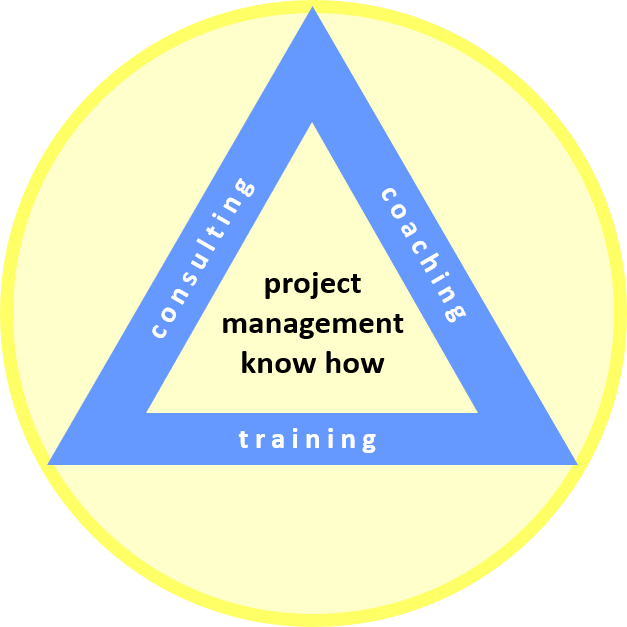

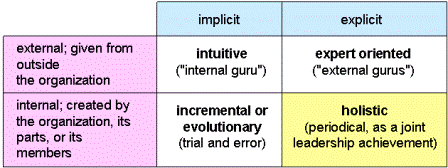



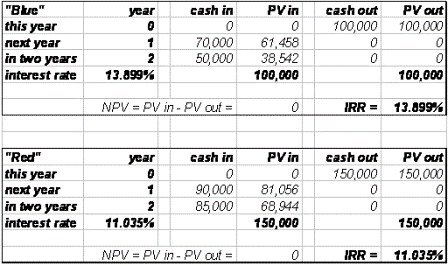


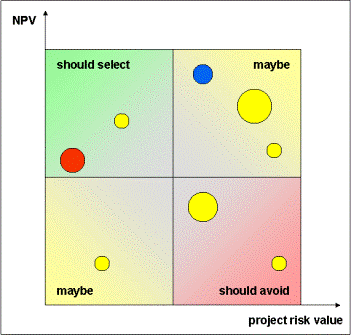
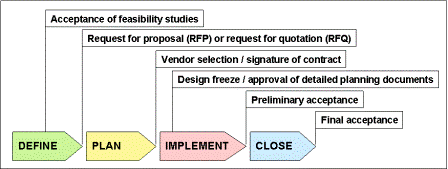
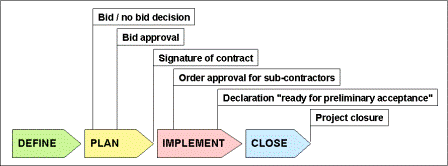
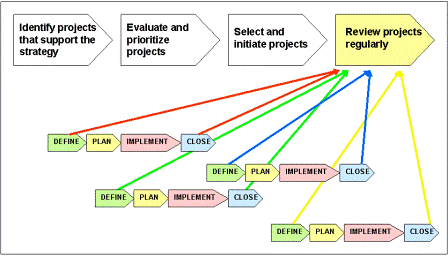

Your Comments
Have your say about what you just read! Leave me a comment in the box below.